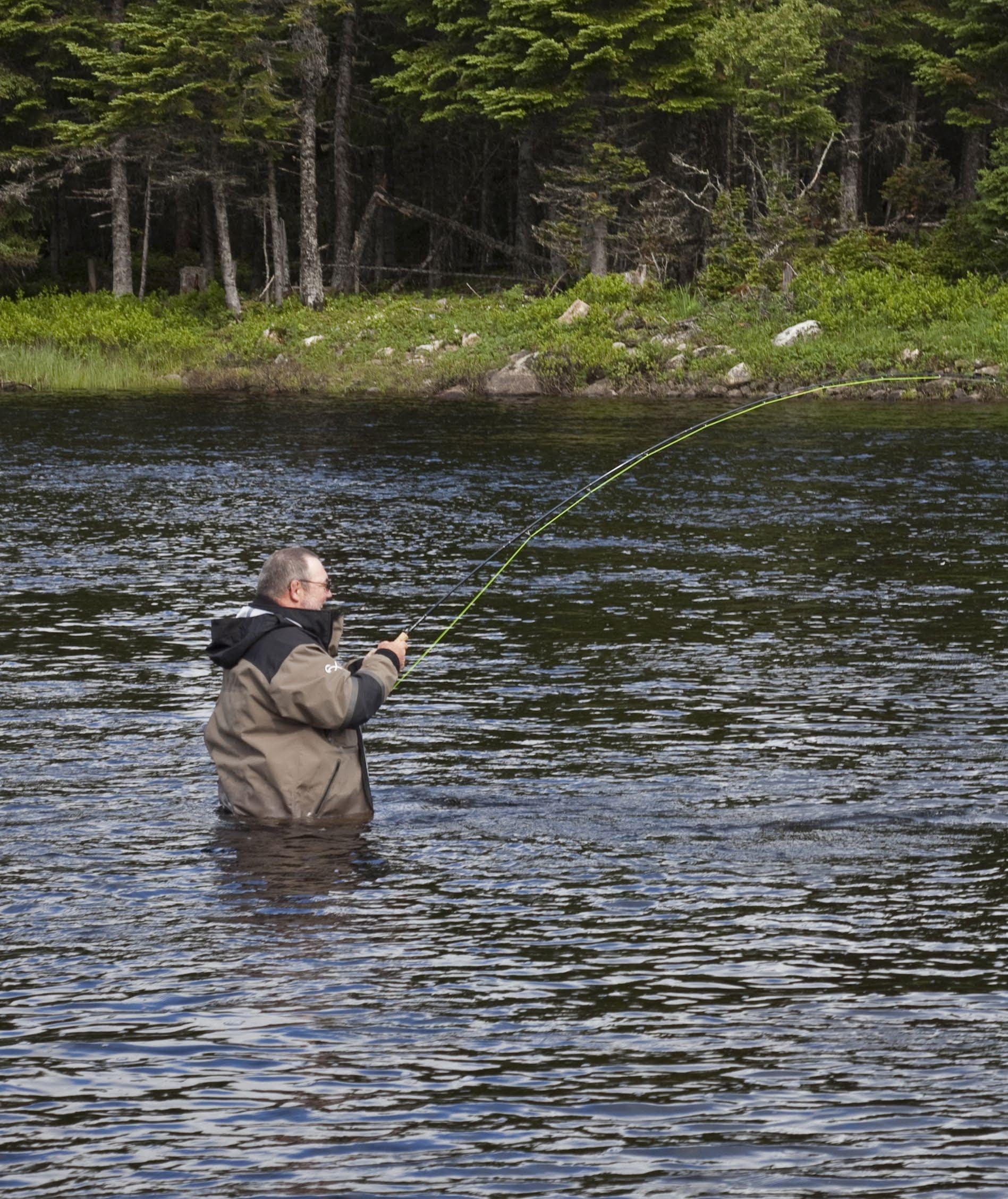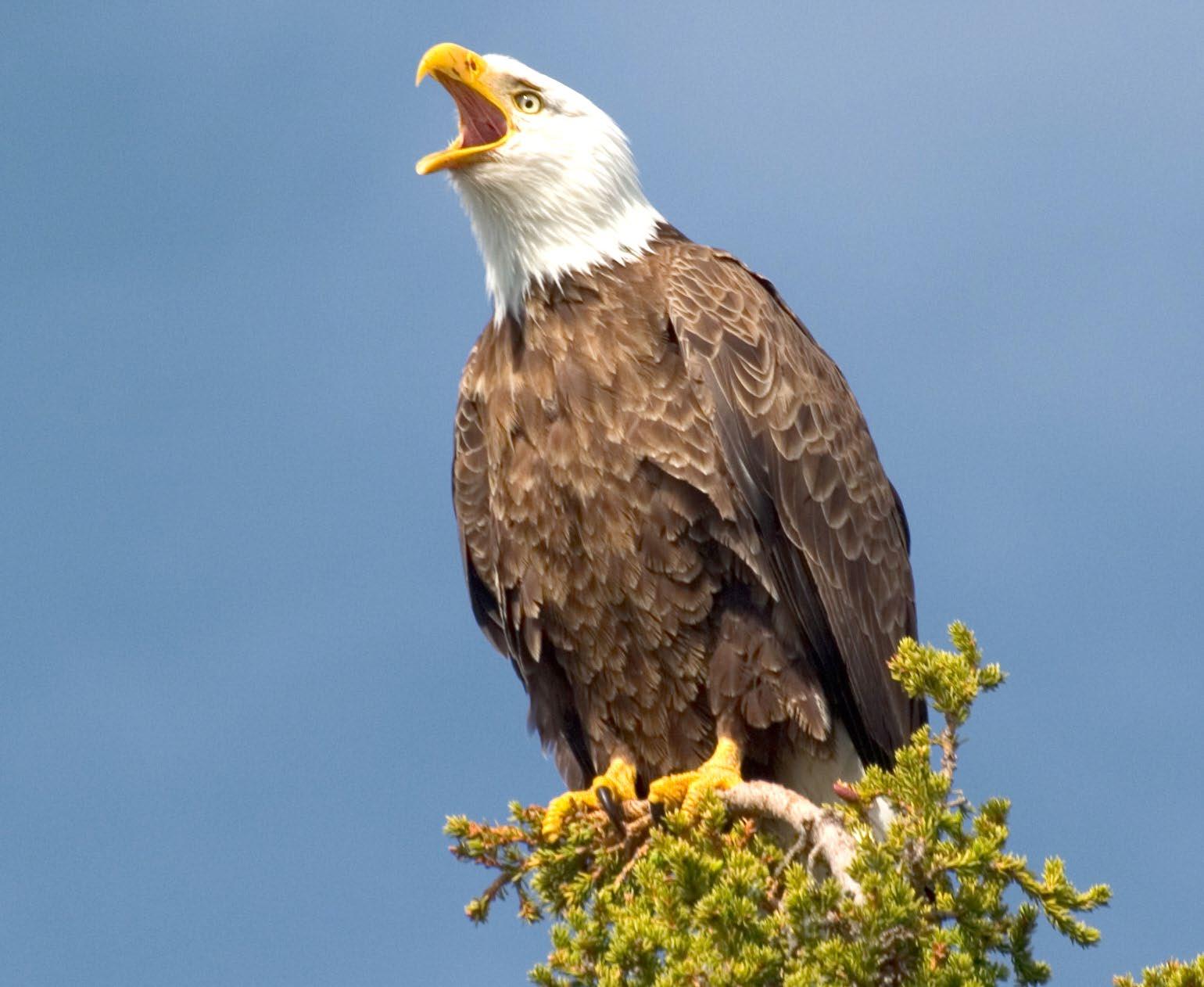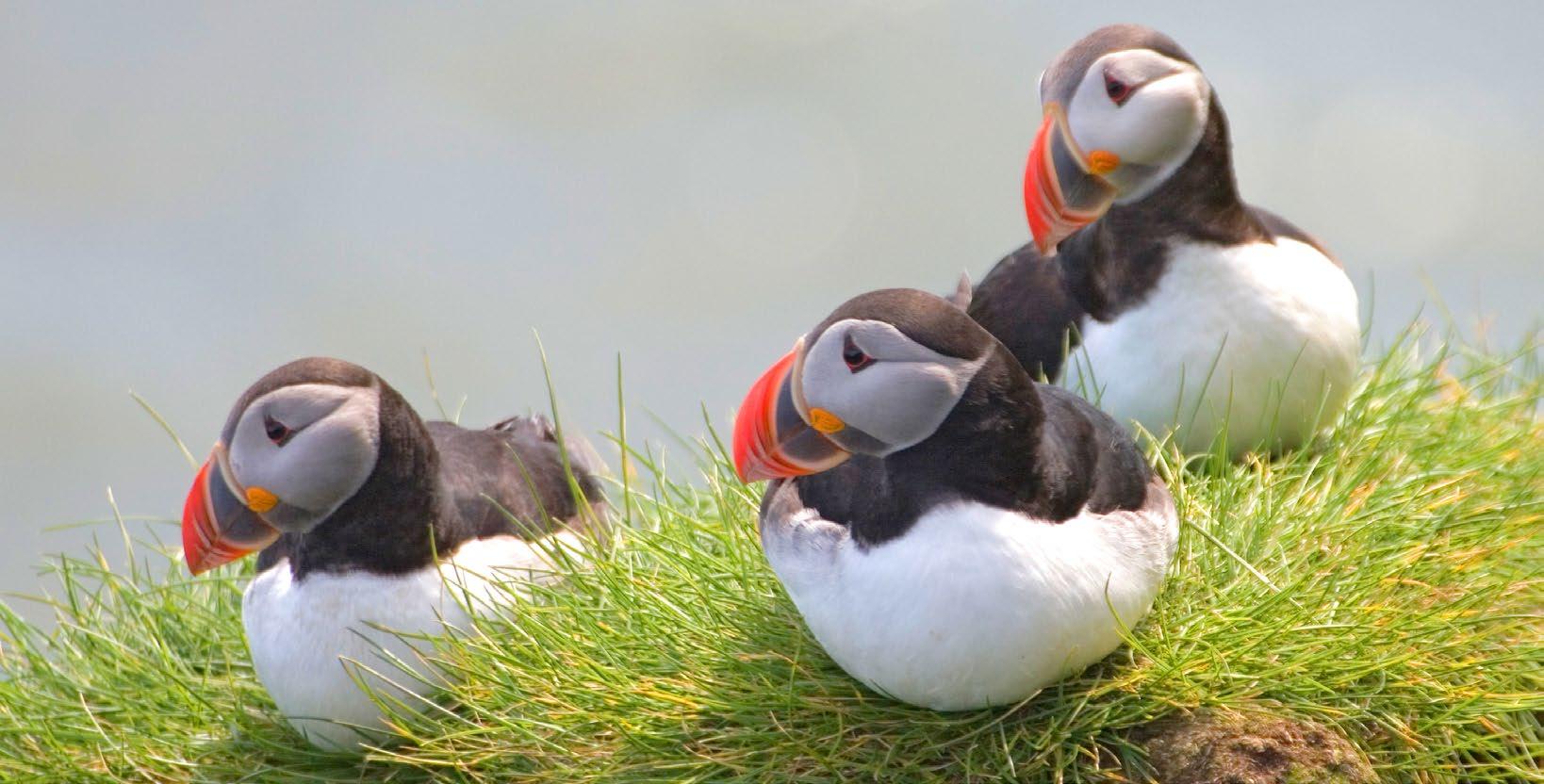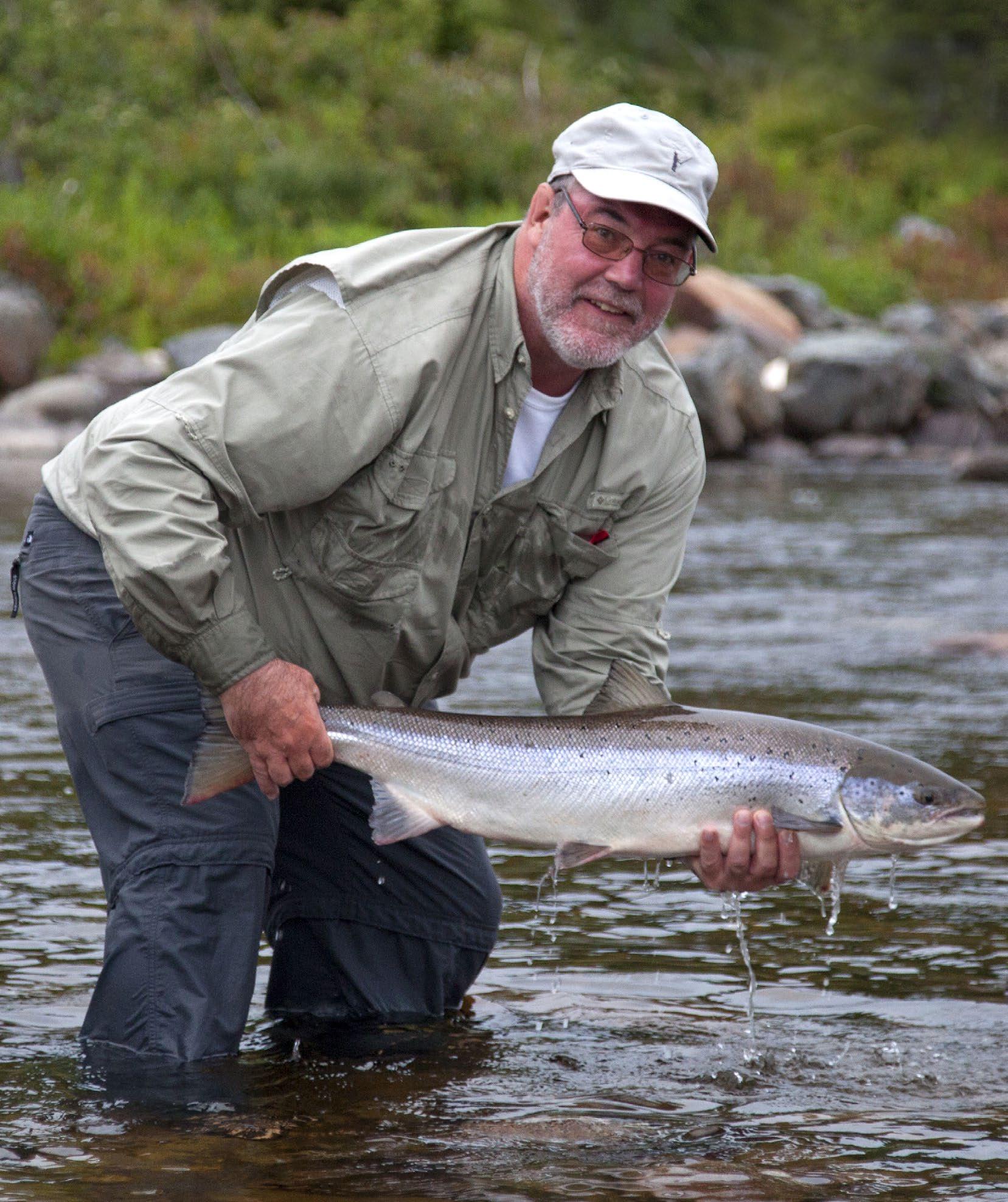
16 minute read
Atlantic Salmon: Chasing Silver in Tuckamoreland
Tuckamore is a typical Newfoundland term for the stunted balsam fir and spruce trees that grow all along the shoreline of the Great Northern Peninsula and the Labrador Straits. Even more unusual, at certain times of the year, this vegetation can produce a very nice fragrance. This odour becomes stronger especially after a little rainfall or when trees are covered with dew. On windy days, the costal air can reach far inland and the people in Newfoundland call it the smell of Tuckamore. Personally, I describe it as “the perfume of the wild”.
By HANS VAN KLINKEN Photography by HANS VAN KLINKEN AND INA STEVENS

Why Atlantic Canada?
The answer is quite simple. I wanted to study and discover the crucial similarities of Atlantic salmon taking (dry) flies in Norway as opposed to those in Atlantic Canada. My ultimate goal was to find out why a salmon takes a dry fly aggressively in certain rivers and yet refuses to come to the surface in other streams. In addition, I wanted to test twenty five years of knowledge of water quality, water levels, water flows, bottom structures and weather conditions which I had gained in Norway.
The only study material I had available was some very detailed data I had written in my fishing diaries over the years. Since the early seventies, I had caught many grilse and even a few big salmon on dry flies. However, very few people believed me. This forced me to continue my exploration on my own. By the end of the eighties, I was successfully able to catch grilse in different parts of Norway using dry flies.
However, my success was limited to only seventeen river systems in central and southwest Norway together with my early salmon experiences in the far north of Norway. Another important observation I made was that my success in catching salmon with dry flies was limited to warm or even extremely warm weather conditions. A similar striking observation was that nine of the seventeen rivers were either tidal, or still in estuary regions with a nice tidal current. The salmon or sea trout I caught in these rivers were some of the largest I have ever landed.
In the late eighties my interest in dry fly fishing for salmon and sea trout had become so intense that I began to look for articles and stories about Atlantic salmon caught on dry flies. My search quickly lead me to fly fishermen and fly tiers who were familiar with fly fishing in Atlantic Canada, New Brunswick, Quebec and even in parts of the State of Maine, USA.

Barb Genge “The Lady of the Wild”
In the mid nineties, my wife and I began taking extensive trips to fish the salmon rivers in Nova Scotia, New Brunswick, Newfoundland and Labrador. And fish we did!
Although we learned a lot, we found the most successful fly-fishing techniques we employed on these trips were not so much different from what I had been using in Norway for so many years. For us, Newfoundland quickly became our favourite destination to catch the elusive Atlantic salmon on dry flies.
That is not to say other provinces in Atlantic and Eastern Canada are not also spectacular for dry fly fishing. To explain this you need to understand that the work schedules in our regular jobs only allowed for travel in June and early July. Fortunately, this period of time coincided with the Newfoundland salmon runs.
In addition, we had many friends who were willing to guide us and that made the Newfoundland trips easy to organize. Anyway, during all these wonderful trips we stayed at many great locations and fished with experienced and knowledgeable guides: guides like Bill Stephens, the late Marc Madore, Tony Tuck, Gord Robinson, Barry and Janice Sweetland, John McCarthy, John Parson, Tuckamore’s Junior, Brendan and Clarence and not to forget our singing guide Keith Cornier. But in the end, wherever we went we always seemed to end up at the Tuckamore lodge with Tuckamore Barb. I have been continually amazed by Barb’s enthusiasm and skills – and, not least, her ability to bring people back to nature with her stories of the wild.

Blood, sweat and tears
Not many people will ever appreciate that Tuckamore Lodge has survived solely because of the perseverance and dedication of one great Lady. Barb Genge found herself in a marriage and an outfitting business, both of which had just broken down. Facing huge debts and all by herself, except for her 12 year old son, many people just wanted her to give up and go away. It was a difficult time and she was entering a male dominated business.
Knowing there would be no support from government and no hunting licenses available; she began the journey of recovery. She found strength in knowing and believing that anything worthwhile never comes without hard work.
Although Tuckamore Lodge originally started as a hunting lodge, she was quick to realize she needed to give the lodge a new identity to be successful. Getting the salmon to return in serious numbers again would be her goal. In addition, she knew she would have to improve her personal skills.
The first step in her effort to get the salmon to return in serious numbers again was to restore the nearby rivers from the neglect and the aftermath of the logging industry. To ensure that returning salmon would be able to follow their way upstream to the best spawning grounds, an enormous clean-up program was required. Under Barb’s watchful leadership, a few dedicated enthusiasts and highly motivated individuals began cleaning up the Salmon River with their bare hands. Thanks to them, we now have a new generation of salmon returning in record numbers. It was not an easy task for Barb to achieve her dream of creating a real fly-fishing paradise in the north. However, each guest and returning angler is in awe at what she has accomplished at Tuckamore Lodge.

The past, present and future
During our very first visits to Tuckamore Lodge, Barb was already offering her fly fishing guests a real fishing paradise. The nearby Salmon River and Southwest River were perfectly suited for my research in identifying any connections between my fishing successes in Norway and those salmon that took the dry fly so well in Newfoundland. The travel time from the lodge to the nearby rivers is short, and the watercourse, current and bottom structures were very similar to the rivers I had fished in Norway for so many years. The similarity of the river systems was very important to test and evaluate my Norwegian fly-fishing techniques in an objective manner.
In the past, I always found a good run of grilse in the Southwest Brook and Salmon River. The salmon fishing season begins in late June and continues to the early days of September. The Atlantic salmon in this area weighs, on average, between six and ten pounds. Real salmon (salmon over 3 kg in weight that have stayed longer than one year at sea) I have only caught in the Salmon River and the number of real trophy fish grows every year.


In addition to the salmon there is also the challenge of brook trout, Arctic char, and sea run brook trout. I caught a whole bunch of the latter in some sheltered water of the Grey Islands when experimenting with my leadhead and some streamers. While fishing the Salmon River and Southwest Brook quite extensively over many years, I was also lucky to deal with some exceptional weather as well. I ran into very cold temperatures and experienced very high water levels, but also had to fight a few serious heat waves in which the water had dropped to dramatic low levels.
Air temperatures around 10 degrees Celsius and lots of rain during our 1997 and 2011 trips were responsible for us not doing so well with our dry flies, but we did well while using wet flies in much bigger sizes than most local people used. My Bondal series of flies, for example, were absolutely great under those circumstances.
While I studied the Salmon River, I discovered that at several places the current was rather slow, almost dead. When most fish rolled at the edge of each current, it came to my mind to try to tempt some fish by using small, unweighted nymphs. I never tried it before in Atlantic Canada, so the challenge was born. I could use the dead water to let the nymph sink well under the surface, and if I would move it with a very slow retrieve, it might work. It’s a technique that is extremely popular for catching whitefish on fly, and since I use several of my grayling techniques to hook salmon by dry fly, why couldn’t this work as well? I prepared a new leader and tied on a 4 lb, almost two-meter long tippet, instead of the normal 6 lb. I believed any trick to present the nymph as deep as possible under the surface could improve my chances.

When my equipment was ready, I gave it a try; at first it didn’t look very hopeful. I started to experiment by giving the nymph more time to get down and started to use the Charles Brooks method to present the nymph as deep as possible. Maybe a dozen casts later I hooked a fish, and it felt like a big one too. I was afraid I might have false-hooked it, but I also had my doubts about this because the retrieve was too slow and I didn’t strike or set the hook either.
No, it was hooked properly and it was a big salmon and it gave me a really good fight. About 20 minutes later, the same happened. Again and again it was salmon, I landed and released three before another hour was finished. In just two hours I had caught the day limit! In present days and several years after my last visit, I could not wait to see how the fishing had further developed. I was totally amazed because the salmon runs had improved again, and success in fly-fishing had increased a lot as well. There also were some new salmon rivers to try and we did some amazing fly-fishing in one of the estuaries. It is now estimated that about twelve to eighteen thousand young Atlantic salmon return to the nearby rivers each year.
For less experienced fly fishers or when it is simply too windy to fish the Salmon River or Southwest River it is very nice to visit the Beaver Creek and also have a look at the famous “underground hole” which can be seen as a real geological wonder. As far as I understood, this is the only place in the world where Atlantic salmon swim through two large underground chambers and holes to reach their spawning grounds. I heard stories that blind salmon reached their spawning grounds but that they migrate underground in complete darkness was completely new to me. The fishing is allowed until 100 meters before the underground hole and it is absolutely worth to give it a try!
In 2012 we once again experienced dramatic low waters but the temperatures were much lower than in 1999, so different tricks had to be used. The river was full of big salmon and again I had success with my salmon nymphs, however, this time they were tied on my new salmon hooks and quite different from the patterns I was using in 1999 as well. The year 2012 was the year in which I caught more salmon than grilse in the same season. My most spectacular catch was an 87 cm salmon that I hooked and landed on my #5 weight outfit while fishing for brook trout with a size 16 dry fly!

Lessons learned by experiences and observation
From earlier lessons and experiences, I have learned that as soon as the air temperature gets higher than the water temperature that is when you can start using dry flies for salmon.
It is even used as a rule of thumb by several of my close friends. However, when the water temperatures get too high and the amount of oxygen drops to a critical level, most salmon will hide in deep lies with their nose down at the bottom and become inactive, to save their strength for their upstream journey and spawning.

I don’t like rules for salmon fishing and I always keep in mind what Lee Wullf once told me: “The only definite thing that you can say about salmon, is that you can not say anything definite about them” and I really believe this rather strongly. Another striking lesson that I learned in Atlantic Canada was that fishing rising water was not so good, but from the time it has peaked and started to drop, it is prime time for many rivers. (In Norway however I experienced exactly the opposite, the best wet fly fishing for salmon was during rising water and I caught most fish during these periods). In both places I found dry fly fishing the best at To fish a dry fly for Atlantic Salmon, you do not have to see fish move to be successful and if you are in a pool that you know holds fish, you can cover the water in a general way just as effectively as with any wet fly. I often fish a good-looking pool with the picture of an empty chess board in my mind, which I place over the pool. I only number the rows and use the columns for when I start moving in the water. The nearest row I give number one and I make the rows as long as the fish can have their lies. I don’t walk through the pool right away, but just fish it from the most upstream position first.
I try to cover as many rows and squares as I can by casting slightly upstream and working my way downstream through my invisible grid. Every time I fish for salmon, I see lots of people getting in the water as far and deep as possible and take their position exactly at the place were the salmon have their lies.
The next mistake they make is casting too far and letting their flies cover water that actually holds no fish at all. Therefore in small rivers, I even try to not get in the water at all when I begin with this useful and very powerful trick. When I have a pool all to myself, I start as much upstream as I can and try to cover as many rows and squares as possible. Each square I imagine about eight steps wide and long. This makes the fishing much more effective and well organized. If I have finished all the rows within my casting range, I make eight steps downstream. Then I follow exactly the same process, starting from my second column and by starting, covering row number one first. This is how I work myself through the entire pool, with casts sometimes not much longer then 10-12 ft.

I am a big fan of long drifts, but I also discovered that in some waters, too many long drifts scare the fish and keep them down, so in those rivers, the above method is a powerful trick that works extremely well. Through other experiences and observations in my dry fly fishing, I discovered that there isn’t so much difference in fishing large or small rivers, as long you know the places that hold fish. However, a smaller river has my preference and I personally love fishing rivers that are about 40-50 ft wide, because you can cover all the water from just one bank. In spite of this preference, I have had some great experiences with fly fishing in estuaries, sea pools and brackish water in Norway; I have not experienced similar circumstances in Atlantic Canada, but my recent experiences have led me to believe that it does not matter how far you are away from the sea when using a dry fly in the rivers in Newfoundland.
I really don’t like coloured water for dry fly fishing by which I don’t mean the brown tannic acid colour that you see in many rivers in Atlantic Canada. It was a huge link to my successes in Norway, because most rivers in which I enjoyed success all had concentrations of tannic acid. Unfortunately, I never performed any serious testing with regard to the correct concentration of tannic acid, which I really regret nowadays. On both sides of the Atlantic, I discovered that when rivers are getting low and fish stay longer in the pools, they come up for much smaller flies. I strongly believe that the longer salmon stay in one pool, the better or stronger their old feeding memory returns.
I remember very well how I did my fly-fishing in three huge pools directly below a big waterfall in the Nordelva River in Norway. At the time, this place did not have any road access at all. It is one of the few rivers that I know of, where salmon first start to run upstream when the river is extremely low, because the only way for them to get up this waterfall was at very low water. The pools are deep and hold hundreds of fish, but I only succeeded here when fish started head and tailing, and while using small flies presented with an absolutely drag free drift. The fish would only act like porpoises for about 20 minutes and only once every four hours or so, but each time they behaved like that, I caught fish and that has been going on like that for many years.
I have had exactly the same experiences in several of Newfoundland’s rivers too. The most extreme example of any small dry fly success is my catch of four grilse on the same day on a # 16 dry fly and all fish were head and tailers. In exactly the same pool and two days later I caught four salmon on a size 2/0 dry fly in heavy rain. I also have situations in which I caught a 91cm salmon on size 16 dry fly and few hours later a small grilse on a size 1/0 dry fly in heavy rain. Everything is possible with dry fly fishing for Atlantic Salmon.






